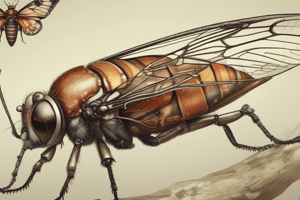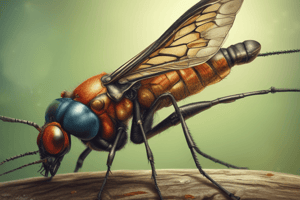Podcast
Questions and Answers
What is the primary location where waste products are emptied into the alimentary canal in insects?
What is the primary location where waste products are emptied into the alimentary canal in insects?
- Foregut
- Hindgut, at the beginning of the Anterior hindgut
- Midgut
- Hindgut, via Malpighian tubules (correct)
What is the term for parasites that live inside the host?
What is the term for parasites that live inside the host?
- Endoparasites (correct)
- Digestive parasites
- Parasitoids
- Ectoparasites
What is the main function of the Gizzard in an insect's alimentary canal?
What is the main function of the Gizzard in an insect's alimentary canal?
- Mechanical breakdown of food (correct)
- Producing digestive enzymes
- Filtering food particles
- Absorbing nutrients
What is the term for insects that capture prey by speed in pursuit?
What is the term for insects that capture prey by speed in pursuit?
Which of the following insects are ectoparasitic for a short period while feeding?
Which of the following insects are ectoparasitic for a short period while feeding?
What type of legs do Oligopod larvae have?
What type of legs do Oligopod larvae have?
What type of pupa has appendages fused to the body?
What type of pupa has appendages fused to the body?
Which type of diet involves consuming plant or animal remains?
Which type of diet involves consuming plant or animal remains?
What type of mouthparts are primitively found in insects?
What type of mouthparts are primitively found in insects?
What type of insects consume animal tissues?
What type of insects consume animal tissues?
What type of insects may be used as biological control agents?
What type of insects may be used as biological control agents?
What is the primary function of spiracles in insects?
What is the primary function of spiracles in insects?
What is the primary function of hydrofuge hairs in aquatic insects?
What is the primary function of hydrofuge hairs in aquatic insects?
Which of the following adaptations allows aquatic insects to obtain oxygen from the water?
Which of the following adaptations allows aquatic insects to obtain oxygen from the water?
What is the term for the fine branches of the tracheal system that penetrate individual cells?
What is the term for the fine branches of the tracheal system that penetrate individual cells?
Which of the following insects must return periodically to the surface to breathe?
Which of the following insects must return periodically to the surface to breathe?
What is the term for the system of internal tubes that bring oxygen directly to individual cells in insects?
What is the term for the system of internal tubes that bring oxygen directly to individual cells in insects?
Flashcards are hidden until you start studying
Study Notes
Insect Capture and Parasitism
- Insects can capture prey by speed in pursuit, trapping, or using modified appendages
- Parasites live off a host without killing it, with ectoparasites living externally and endoparasites living inside
- Blood-sucking insects can be ectoparasitic for a long period or only while feeding
Digestive System
- The insect alimentary canal can be divided into three sections: foregut, midgut, and hindgut
- The foregut consists of the oral cavity, salivary glands, pharynx, oesophagus, crop, and gizzard
- The midgut consists of the ventriculus and caecum
- The hindgut consists of the anterior hindgut, rectum, and valves
- Waste products are emptied via Malpighian tubules into the alimentary canal at the beginning of the hindgut
Larval Forms
- Larvae of butterflies or moths have oligopod larvae with only three pairs of sclerotized, jointed legs
- Apod larvae have no legs
- Larvae of many ants, bees, wasps, and flies (maggots) have no legs
Pupal Forms
- Obtect pupae have appendages fused to the body
- Exarate pupae have appendages free from the body
- Coarctate pupae are contained within the last larval exoskeleton, the puparium
Diet and Feeding
- Diets can be classified as saprophytic, phytophagous, or carnivorous
- Saprophytic insects consume plant or animal remains
- Phytophagous insects feed on plant parts, with mouthparts adapted for chewing, piercing, and sucking
- Carnivorous insects consume animal tissues and may be used as biological control agents
Respiration
- Insects have a waterproof cuticle, but some live in moist areas and are sedentary with permeable cuticles
- Most insects have a special respiratory system comprising a system of internal tubes, called trachea
- Air enters from the outside through a series of openings, spiracles, which are typically located on the thorax and abdomen
- Aquatic insects have adapted respiratory systems, such as tracheal gills or hemoglobin in their blood
- Some aquatic insects have hydrofuge hairs to break the surface tension of the water and keep water out when underwater
Studying That Suits You
Use AI to generate personalized quizzes and flashcards to suit your learning preferences.




